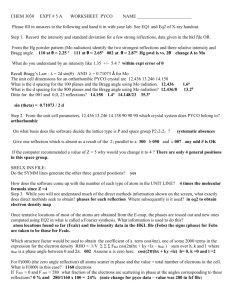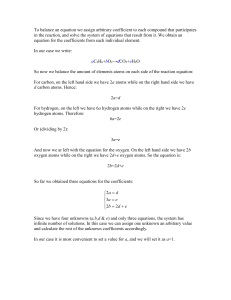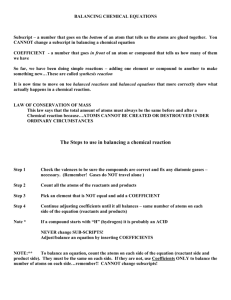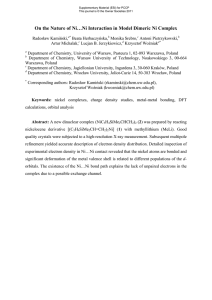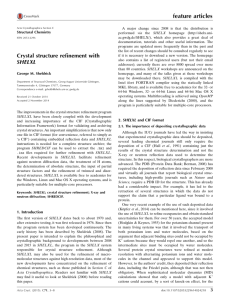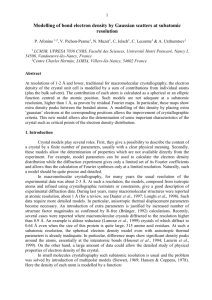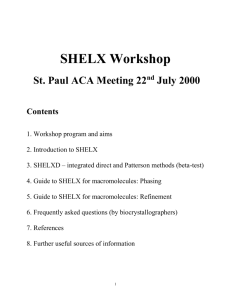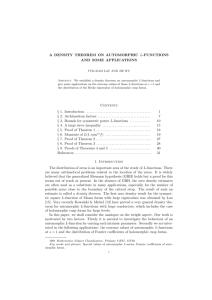ref atoms
advertisement
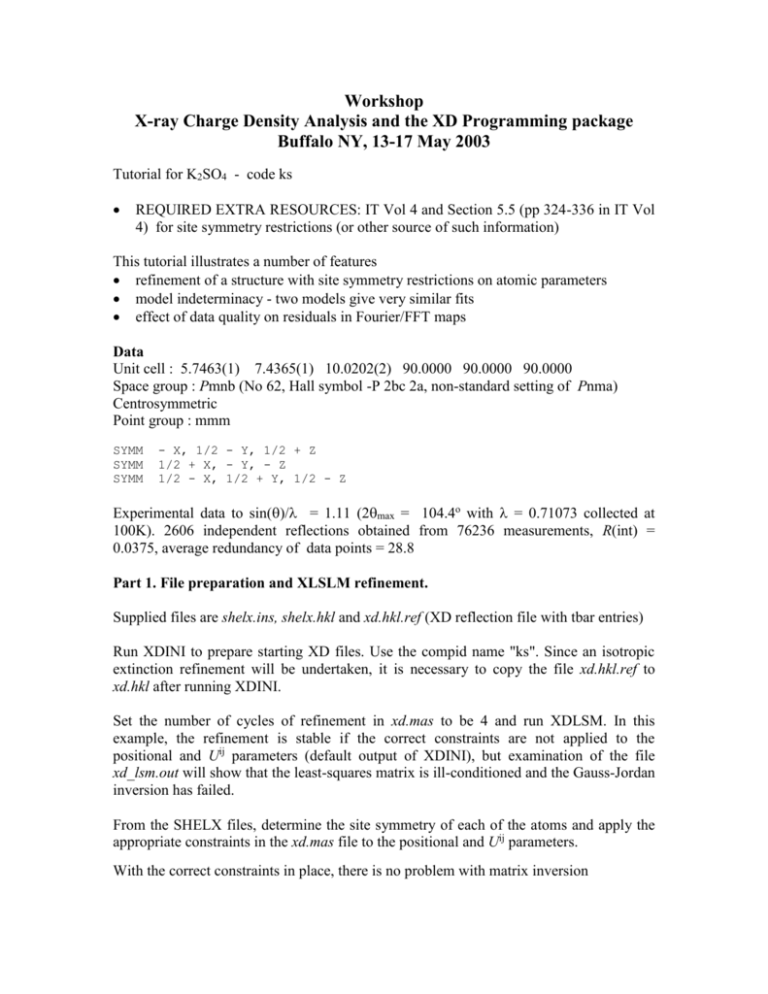
Workshop X-ray Charge Density Analysis and the XD Programming package Buffalo NY, 13-17 May 2003 Tutorial for K2SO4 - code ks REQUIRED EXTRA RESOURCES: IT Vol 4 and Section 5.5 (pp 324-336 in IT Vol 4) for site symmetry restrictions (or other source of such information) This tutorial illustrates a number of features refinement of a structure with site symmetry restrictions on atomic parameters model indeterminacy - two models give very similar fits effect of data quality on residuals in Fourier/FFT maps Data Unit cell : 5.7463(1) 7.4365(1) 10.0202(2) 90.0000 90.0000 90.0000 Space group : Pmnb (No 62, Hall symbol -P 2bc 2a, non-standard setting of Pnma) Centrosymmetric Point group : mmm SYMM SYMM SYMM - X, 1/2 - Y, 1/2 + Z 1/2 + X, - Y, - Z 1/2 - X, 1/2 + Y, 1/2 - Z Experimental data to sin()/ = 1.11 (2max = 104.4o with = 0.71073 collected at 100K). 2606 independent reflections obtained from 76236 measurements, R(int) = 0.0375, average redundancy of data points = 28.8 Part 1. File preparation and XLSLM refinement. Supplied files are shelx.ins, shelx.hkl and xd.hkl.ref (XD reflection file with tbar entries) Run XDINI to prepare starting XD files. Use the compid name "ks". Since an isotropic extinction refinement will be undertaken, it is necessary to copy the file xd.hkl.ref to xd.hkl after running XDINI. Set the number of cycles of refinement in xd.mas to be 4 and run XDLSM. In this example, the refinement is stable if the correct constraints are not applied to the positional and Uij parameters (default output of XDINI), but examination of the file xd_lsm.out will show that the least-squares matrix is ill-conditioned and the Gauss-Jordan inversion has failed. From the SHELX files, determine the site symmetry of each of the atoms and apply the appropriate constraints in the xd.mas file to the positional and Uij parameters. With the correct constraints in place, there is no problem with matrix inversion Now decide on a suitable local coordinate system for the multipoles on all the atoms (the z axis is normally chosen as the symmetry axis and the index picking rules given in the XD manual adhere to this convention). You may find it expedient to include dummy atoms to achieve this. An isotropic extinction correction should also be applied (type1 with a Gaussian distribution). Now refine the multipole parameters in suitable stages, increasing the multipole expansion to hexadecapoles on all atoms. Keep ' fixed at 1.0 for all atoms, and refine against F using the data with F > 0.0 and F/(F) > 3.0. Explore TWO models, one where the only restriction on the monopole populations is that the cell has overall electroneutrality, the other where the ions are fixed at their "standard" charges (HINT - there are significant implications if the K atoms are treated as K+ ions). You should not refine the ' parameters of any atom, and you should find that the parameter on the K atoms does not refine sensibly (it gives large shifts and unreasonable values). Do you have a suggestion why this may be the case? You should find that the second model gives virtually as good a fit (in terms of R values and difference density residuals) as the more extensive model with multipole expansion on the K atoms, but uses fewer parameters. Look critically at the standard deviations and magnitudes of the multipole populations of the K atoms for the first model. Finally, in separate directories prepare refinements of both models, but with the ' parameters for the S and O atoms refined to convergence. Part 2. Use of properties to assess model and assessment of data quality For all models you have prepared, run XPROP jobs to search for the critical points in and the bond paths. You should find that there are two types of bcp's - those between the S and O atoms and also some between the K and O atoms. These may not show up in all models. The absence of expected bond paths is an indicator of a problematical model. Run XDFOUR and XDFFT jobs to ascertain the level and location of residual difference density. The relatively high level of residuals indicates some problem with data quality Run XDWTAN and check the output file xd_wta.out to see if there are any systematic trends in <w(Fo - Fc)> and whether there are any significant outliers Calculate a Laplacian map 6x6Å in a O-S-O plane. Observe the large distortion from spherical symmetry for the S atom. You should also notice a visible difference in the maps between those calculated with and without ' refinement. Calculate approximately where the Valence Shell Charge Concentration should lie (distance from S nucleus) and use the CPSEARCH BUBBLE command in XDPROP to search a suitable annulus of density for the charge concentrations, the (3,-3) critical points in the negative Laplacian.

